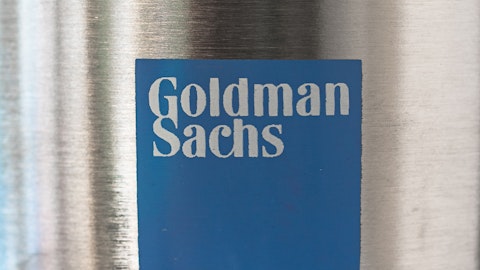The [big-bit] (ph) customers, big media, gaming, are big prospects in compute. And the largest customers there are over $1 billion in third-party cloud spend, typical large media customer, hundreds of millions. And we want to get a share of that business which is much more profitable and ultimately much larger than delivery. So that is our focus here. Obviously we want to get back to PAR. We don’t like to see a declining business but it’s a bigger picture. And of course we are competing with a lot of companies that are very desperate just to get a little bit more growth in delivery, and even if they are doing it at a very unprofitable level, and that makes it more challenging. And Ed, maybe you want to talk a little bit more on the details of the guidance and the confidence?
Ed McGowan: Yeah, as Tom talked about, we use the best information we possibly can. We obviously work with a lot of the big telcos. We try to get feedback from them to see what they’re seeing. We talk to our large customers to get an understanding of what they have planned in terms of the big events or if they’re doing downloads, how big the downloads are going to be, what sort of share we should expect as we go through things like our large renewals and that sort of stuff. When we see a trend like we saw in March where traffic was lower than we expected and then continued into April, it did cause us to go back and relook at our forecasts and be a little bit more cautious. But those forecasts, it’s unusual to see traffic decline month over month.
It doesn’t generally happen. But there is a big pressure in the industry to save costs, especially in the streaming business. Gaming tends to be very seasonal and a little fickle in terms of different titles being popular and not. We’re just sort of in the downtrend in gaming. But as Tom mentioned, we’ve seen these trends before. We’re usually pretty good at predicting when things will turn around. But when we do see something that is concerning, we’re going to call it out and reset our forecast.
Fatima Boolani: I appreciate that. And just with regards to the new go-to-market leadership on the compute side, I’m just curious if there are going to be any material changes or is this a deepening of the bench that’s going to allow for an ongoing, ideally, acceleration of the compute business? We’d love to just get a little bit more detail on that go-to-market change for someone with a pretty excellent category. Thanks so much.
Tom Leighton: Yeah, it’s more of the latter and getting really solid experience and expertise as we increase our investment in the go-to-market effort around compute. And we think Dan is an excellent addition to our leadership.
Operator: The next question comes from Mark Murphy from JP Morgan. Please go ahead.
Mark Murphy: Thank you very much. I wanted to congratulate you on the strength in the Compute and Security and the US Army win the Sony — win, obviously good things happening there. Going back to the social media company that you referenced, is that a typical kind of [garden variety] (ph) case of cost optimization or is there perhaps anything unusual like a corner case where The clock might be ticking on legislative proposals and they are moving in advance of that. Could it be a social media company that is struggling and shrinking? Anything along those lines?
Tom Leighton: No, I think you described it pretty well in the first two descriptions you gave. And they just are a very large customer for Akamai, and a very good customer. They are looking to cut costs and they are looking at potential, geopolitical challenges. And so that, I think a lot of companies look to cut costs, particularly these days in media and maybe they have additional concerns.
Mark Murphy: I understand. Okay. And then Ed, the security company you’re acquiring, I forget the name of it, can you provide any metrics on the headcount or their growth rate in the last 12 months or the gross margins? And I’m just wondering, does it focus on API security that aligns any more or less across any of the particular hyperscalers?
Ed McGowan: Yeah, I’ll take the first part, Tom. You can take the second part about the product. Now in terms of growth rates and stuff like that, I hesitate to give growth rates because we obviously have to translate everything they’re doing into GAAP revenue ASC 606. But needless to say, they were growing pretty quickly. We talked about we think it will contribute about $20 million of revenue, but again growing very fast as we introduce them into the mix. We think we can accelerate that growth rate quite a bit as we introduce them to our customer base. Gross margins I would say is pretty typical of what you see in a software company. It’s called like high 70s, maybe low 80s. There are some people cost that go into your cost of goods sold. As far as people go, right around 250 people, give or take, 60% or so is in R&D, 30% in go-to-market and the rest is sort of mixed in kind of your back-office support.
Tom Leighton: Yeah, in terms of the question on the hyperscalers and API security, they don’t offer API security. They have API gateways, which is something totally different. In our competition, in API security is more startups or younger companies smaller. It’s an emerging field and really we feel Noname as a leader there.
Mark Murphy: Thank you.
Operator: The next question comes from Frank Louthan from Raymond James. Please go ahead.
Frank Louthan: Great, thank you. Just to go back on the delivery side, was there a price that they would have been willing to stick with? There was just pretty much a business decision there. And Tom, you mentioned get back to PAR. What do you mean by that? Is that a level of revenue? How should we think about what it would be to kind of getting back to PAR?
Tom Leighton: Well, PAR, we don’t want to see revenue decline in our portfolio. We’d like to see it to grow. And we’re declining, obviously, now in delivery. And in the particular case of the large social media company, I don’t think, this is a price-related issue, really. And as Ed mentioned, I think pricing, obviously very competitive out there. And we don’t go and chase the bottom stuff that’s not really profitable for us. But you know, pricing is sort of as we expect and more of it’s a traffic, overall traffic in the industry right now.
Frank Louthan: Okay, and at what level do you see the delivery business sort of bottoming it out that would be considered sort of flat for you.
Ed McGowan: Yeah, you know as Tom talked about, it’s hard to predict. I mean, I think what you need to see for that to happen is traffic growth to improve, to see pricing rationalize a bit more than where it is now, and less concentration of big renewals. But that’s really the formula that you would need to see a sort of a stabilized delivery business.
Frank Louthan: Okay, great. Thank you.
Operator: The next question comes from Amit Daryanani from Evercore. Please go ahead.
Unidentified Analyst: Hey, guys. Thanks for taking the question. This is [Chant] (ph) on for Amit. I just had a quick one on the delivery business. You know, given this is an election year, do you think we could see a step up in the delivery business, maybe in the back half? I think normally elections tend to drive some sort of benefit as well as kind of the Olympic benefits you mentioned earlier.
Tom Leighton: Yes, we talked about the Olympics as a decent event for us. Our estimate is $3 million to $4 million this year. As far as the election goes, really hard to tell. You know, we saw back in [2016] (ph) a bit more traffic, [2020] (ph) didn’t really drive a ton of traffic. I’d say this is probably closer to what we saw in 2020, so we’re not really anticipating a significant amount of traffic as a result of this year’s election, but we’ll see.
Unidentified Analyst: Got it. And then just as a follow-up, I think free cash flow is really strong during this quarter, but if I look back historically, Q1 is kind of the low, and then sequentially in the June and September quarter it’s much greater. So could you talk about maybe any changes to your CapEx and free cash flow expectations for fiscal 2024?
Tom Leighton: Yeah, so I would think that next year should play out, or excuse me, 2024 should play out like it’s done in the past. Q1 was a little bit stronger than normal. As we talked about on several calls back last year, we did move some folks to a stock-based bonus program. So we used to have a cash-based bonus program that would play out in Q1 that would drive cash flow down a little bit in Q1, but in terms of the progress throughout the year, it should look like the other years.
Unidentified Analyst: Great. Thanks for that.
Operator: The next question comes from Jonathan Ho from William Blair & Company. Please go ahead.
Jonathan Ho: Hi. Good afternoon. Just wanted to understand the Zero Trust platform that you announced today. Can you talk a little bit about how customers are thinking about purchasing the assembly of products that you’re talking about and how that compares with maybe some of the other views on how SASE and other Zero Trust platforms will evolve over time.
Tom Leighton: Yeah, this is a really good platform for Zero Trust for enterprise applications. So you get your micro segmentation and your employees Zero Trust Network access which is your employee access. That’s your North, South and East, West now combined. Same agents, you don’t have to have two different agents, same console and [plane of class] (ph). And on top of it, you get your MFA, your DNS security, and your threat hunting service, all packaged in a platform. And that’s something customers have been asking for. It makes their lives a lot easier than having what seem to be different products with different agents and different interfaces. On top of it, at RSA we demonstrated a very cool new capability that actually uses a GenAI, LLMs, to give a very nice human interface into your enterprise infrastructure.





